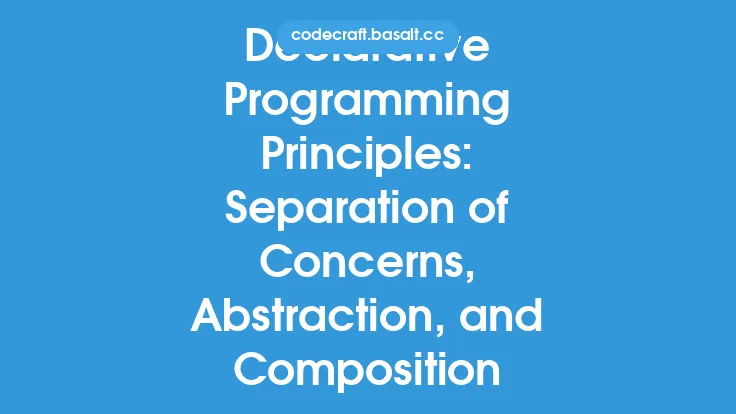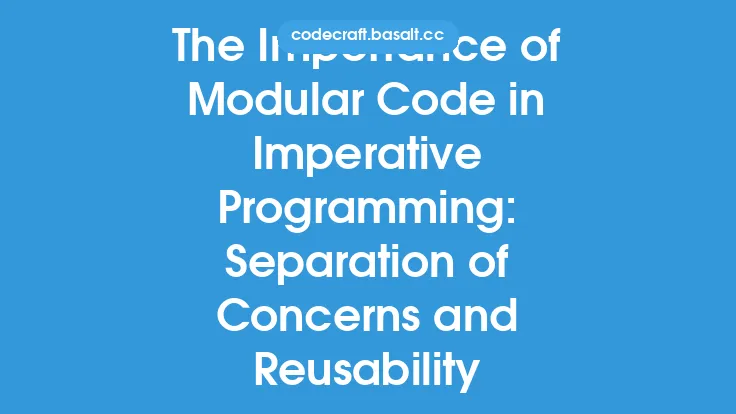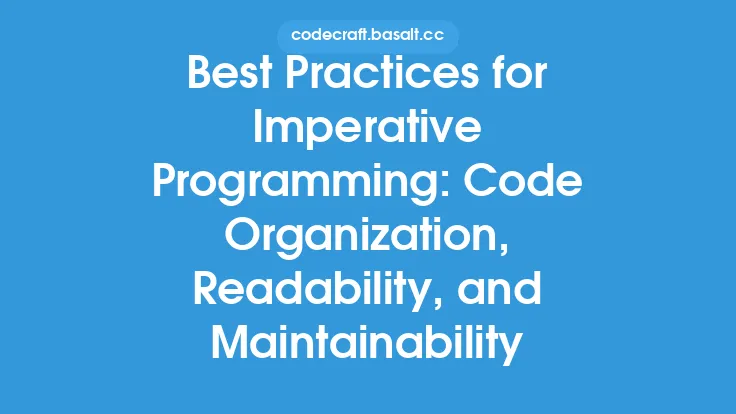Declarative programming is a paradigm that has gained significant attention in recent years due to its ability to improve code readability, maintainability, and scalability. This programming style focuses on specifying what the program should accomplish, rather than how it should accomplish it. By using declarative programming, developers can create more efficient, flexible, and reusable code, which is essential for building complex software systems.
Code Readability
One of the primary benefits of declarative programming is improved code readability. In declarative programming, the code is written in a way that describes the desired outcome, rather than the steps needed to achieve it. This makes the code easier to understand, as the focus is on the what, rather than the how. For example, in a declarative programming language like Prolog, a programmer can write a rule that states "if it is raining, then the grass is wet." This rule is easy to understand, as it clearly states the relationship between the conditions and the outcome. In contrast, an imperative programming language like C would require a series of steps to be written, such as "check if it is raining, then check if the grass is wet, and if so, then update the status of the grass." This imperative code is more difficult to read and understand, as it focuses on the steps needed to achieve the outcome, rather than the outcome itself.
Maintainability
Declarative programming also improves code maintainability. Since declarative code focuses on the what, rather than the how, it is easier to modify and update. For example, if a programmer wants to add a new rule to the Prolog program, they can simply add a new statement, such as "if it is sunny, then the grass is dry." This new rule can be added without affecting the existing code, as the declarative programming style allows for modular and independent code. In contrast, imperative programming languages require the programmer to modify the existing code, which can lead to bugs and errors. Additionally, declarative programming languages often provide built-in support for features like recursion and higher-order functions, which make it easier to write and maintain complex code.
Scalability
Declarative programming also improves code scalability. As software systems grow and become more complex, they require more efficient and flexible code. Declarative programming provides this efficiency and flexibility, as it allows developers to write code that can be easily modified and extended. For example, a declarative programming language like SQL can be used to write queries that retrieve data from a database. These queries can be easily modified and extended, as the declarative programming style allows for flexible and dynamic code. In contrast, imperative programming languages require the programmer to write code that is specific to the task at hand, which can make it difficult to scale and modify the code.
Technical Benefits
From a technical perspective, declarative programming provides several benefits. One of the primary benefits is the ability to use lazy evaluation, which allows the programmer to delay the evaluation of an expression until its value is actually needed. This can improve performance, as it reduces the amount of unnecessary computation. Additionally, declarative programming languages often provide built-in support for features like memoization and caching, which can improve performance by reducing the amount of repeated computation. Declarative programming languages also provide a high level of abstraction, which allows programmers to write code that is independent of the underlying hardware and software. This makes it easier to write code that is portable and reusable.
Real-World Applications
Declarative programming has a wide range of real-world applications. For example, it is used in database query languages like SQL, which provide a declarative way of retrieving and manipulating data. It is also used in artificial intelligence and machine learning, where declarative programming languages like Prolog are used to write rules and constraints that describe the behavior of complex systems. Additionally, declarative programming is used in web development, where languages like HTML and CSS provide a declarative way of describing the structure and layout of web pages. Declarative programming is also used in networking, where languages like SDN (Software-Defined Networking) provide a declarative way of describing the behavior of network devices and protocols.
Best Practices
To get the most out of declarative programming, there are several best practices that developers can follow. One of the primary best practices is to focus on the what, rather than the how. This means that developers should write code that describes the desired outcome, rather than the steps needed to achieve it. Additionally, developers should use declarative programming languages and frameworks that provide a high level of abstraction and support for features like lazy evaluation and memoization. Developers should also use modular and independent code, which makes it easier to modify and update the code. Finally, developers should use testing and validation techniques to ensure that the code is correct and functions as expected.
Conclusion
In conclusion, declarative programming provides a wide range of benefits, including improved code readability, maintainability, and scalability. By focusing on the what, rather than the how, developers can write code that is more efficient, flexible, and reusable. Declarative programming also provides a high level of abstraction, which makes it easier to write code that is portable and reusable. With its wide range of real-world applications and technical benefits, declarative programming is an essential skill for any developer who wants to build complex software systems. By following best practices and using declarative programming languages and frameworks, developers can get the most out of this powerful programming paradigm.





